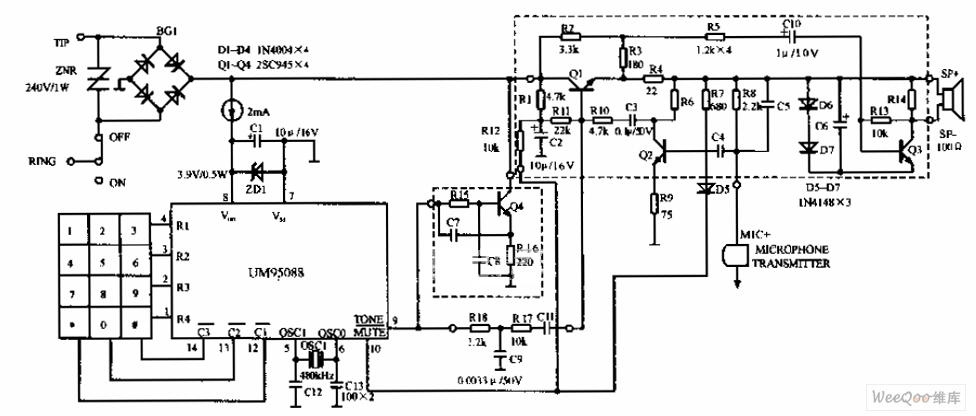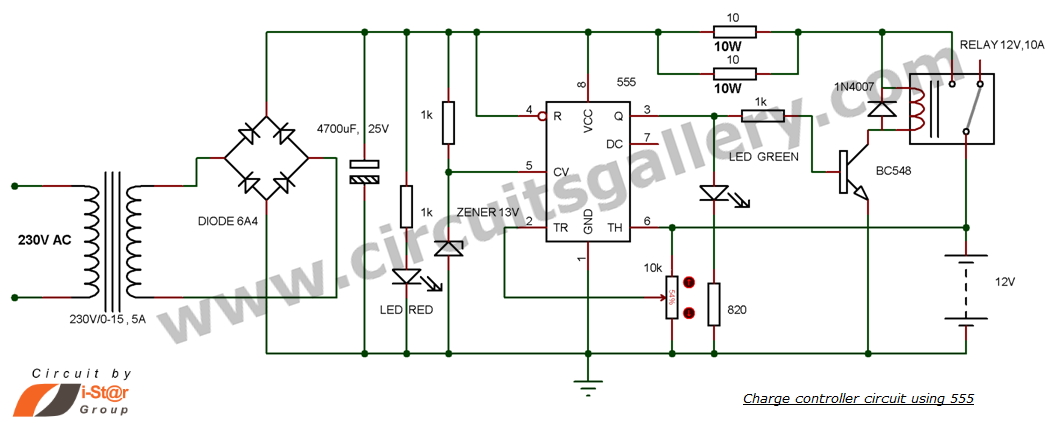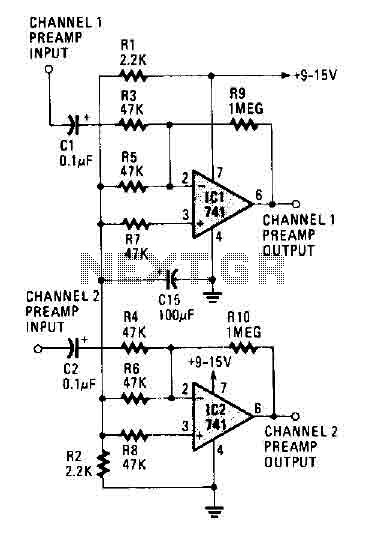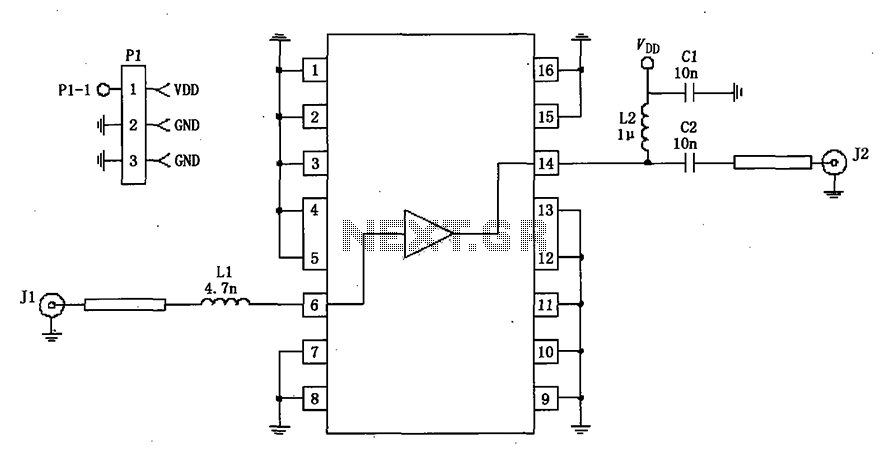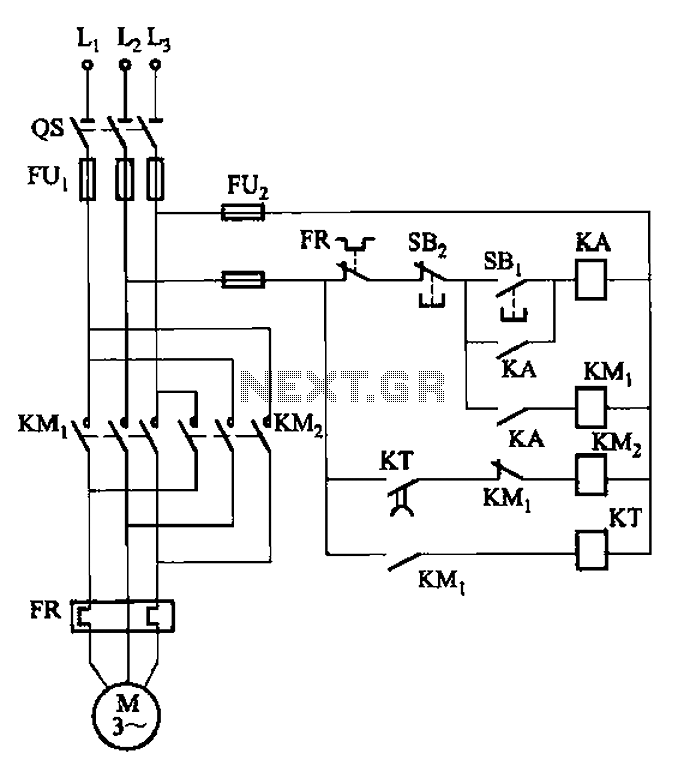
A welding load automatic power-off circuit
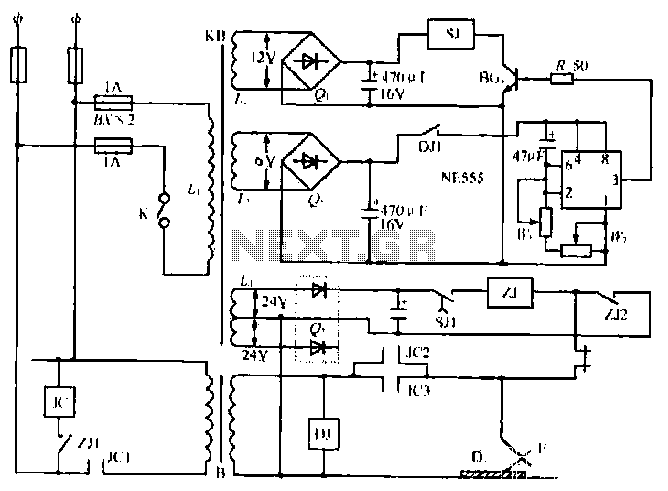
The NE555 timer circuit functions as a vibration generator. The input pin 3 produces pulse frequencies ranging from 5 to 20 Hz. The circuit includes a fan that operates within a bamboo enclosure. The barrel section is designed to accommodate resistors (R) and capacitors (C) for tuning purposes. A transistor is utilized to enhance the system's power output. The circuit features oscillation frequency control through specific components. There are two operational modes: one for standard fan operation and another for bilge selection. A designated mode is configured to maintain a specific frequency. The motor's speed is adjusted based on the load, with an additional mode for compact fluorescent light control.
The NE555 timer is a versatile integrated circuit commonly used for generating precise timing and oscillation applications. In this circuit, the NE555 is configured in astable mode, which allows it to continuously oscillate between high and low states, generating a square wave output. The frequency of this oscillation is determined by the values of the resistors (R1, R2) and the capacitor (C) connected to the circuit. The output frequency can be adjusted within the range of 5 Hz to 20 Hz by changing these component values.
The circuit's output, taken from pin 3 of the NE555, is used to drive a fan located in a bamboo enclosure. The design of the barrel section allows for easy integration of the required resistors and capacitors, ensuring that the circuit can be fine-tuned for optimal performance. A transistor is incorporated into the circuit to amplify the power output, enabling the fan to operate effectively under varying load conditions.
In addition to the basic oscillation functionality, the circuit includes two operational modes. The first mode is designated for standard fan operation, while the second mode is intended for bilge selection, which may be useful in maritime applications where water removal is necessary. The "withering contingent" mode is an additional feature that stabilizes the output frequency for specific applications.
The motor speed can be controlled dynamically based on the load it experiences, allowing for efficient operation. The circuit may also include a control segment designed for compact fluorescent lights, enabling it to manage the light's operation in conjunction with the fan's function. Overall, this NE555-based circuit is a well-rounded solution for applications requiring vibration generation and motor control.NE555 tour allows just as vibration. } E input pin 3 River) pulse frequency ult / 5 ~ 20Hz Fan Cave weeks bamboo. Barrel section to ridicule steep scheduled for R and C. Value. m transistor 1j and T} Hungary throw success rate system level power output fl1 sail. AJl and f can control the oscillation frequency of 555. There are "Shai fans" and "shift" models t bilge selection. "Withered contingent" mode is set f rinse certain frequency. Juice motor drawing to determine the speed. "Change" Bu marrow type the compact fluorescent Sichuan F1 motion control segment continued Ba f f Section vmiiJ pupil Cui motor speed.
The NE555 timer is a versatile integrated circuit commonly used for generating precise timing and oscillation applications. In this circuit, the NE555 is configured in astable mode, which allows it to continuously oscillate between high and low states, generating a square wave output. The frequency of this oscillation is determined by the values of the resistors (R1, R2) and the capacitor (C) connected to the circuit. The output frequency can be adjusted within the range of 5 Hz to 20 Hz by changing these component values.
The circuit's output, taken from pin 3 of the NE555, is used to drive a fan located in a bamboo enclosure. The design of the barrel section allows for easy integration of the required resistors and capacitors, ensuring that the circuit can be fine-tuned for optimal performance. A transistor is incorporated into the circuit to amplify the power output, enabling the fan to operate effectively under varying load conditions.
In addition to the basic oscillation functionality, the circuit includes two operational modes. The first mode is designated for standard fan operation, while the second mode is intended for bilge selection, which may be useful in maritime applications where water removal is necessary. The "withering contingent" mode is an additional feature that stabilizes the output frequency for specific applications.
The motor speed can be controlled dynamically based on the load it experiences, allowing for efficient operation. The circuit may also include a control segment designed for compact fluorescent lights, enabling it to manage the light's operation in conjunction with the fan's function. Overall, this NE555-based circuit is a well-rounded solution for applications requiring vibration generation and motor control.NE555 tour allows just as vibration. } E input pin 3 River) pulse frequency ult / 5 ~ 20Hz Fan Cave weeks bamboo. Barrel section to ridicule steep scheduled for R and C. Value. m transistor 1j and T} Hungary throw success rate system level power output fl1 sail. AJl and f can control the oscillation frequency of 555. There are "Shai fans" and "shift" models t bilge selection. "Withered contingent" mode is set f rinse certain frequency. Juice motor drawing to determine the speed. "Change" Bu marrow type the compact fluorescent Sichuan F1 motion control segment continued Ba f f Section vmiiJ pupil Cui motor speed.
